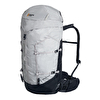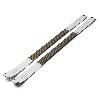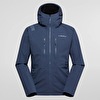Thoughts about alpinism, climbing and accidents

 1 / 10
1 / 10 Elio Bonfanti
Elio Bonfanti
Those days are long gone, nothing but a distant memory for the old, and with the advent of the Internet all personal experience has gone to hell. I don't want to be misunderstood as I believe that the Internet is a powerful tool that has helped attract thousands to this vertical sport. It has however drastically reduced the distance between ace champions and weekend sportsmen, lowering in some of us our threshold of attention and self-criticism. Riccio 61 climbed that route and he said it's good. OK, so I'll do it too (unaware that Riccio 61 can do 7a trad blindfold). A 24-hour weather window? I'm off! The couloir was climbed yesterday, a track has already been beaten, 3 hours for the approach followed by 8 for the ascent and a further 3/4 to descend, it'll be a piece of cake. But that day something goes wrong and the 15 hours suddenly transfer into a whole lot more and an emergency bivy is needed. The weather window closes in on us and we're still out in the mountains.
Seeing that certain routes used to have only two or three repeats a year and that now queues form at their base, I'm lead to think that either we've all become phenomenal climbers or that many of us are simply taking unacceptable risks. Last autumn I believe the French Gendarmerie helicopter was practically at home on the Polish route on the North Face of the Grandes Jorasses, plucking off alpinists unable to climb through the crux. And we're talking about a route that, for good reason, had only a handful of repeats, on the North Face of the Jorasses and not Campanile di Val Montanaia that, no matter how beautiful it may be, pales in comparison. It seems to me that we're pervaded by a wave of trivialisation. So now, apart from me, who hasn't made it up the Eiger? The route dates back to 1938... it can't be that bad! Surely though we can have a positive impact on the world and the people we know, without having to dodge in and out of some weather window, cling to a micronut or, worse still, solo a route. None of us are Dave MacLeod, the first that springs to mind who, after having made the famous climb protected by a micronut, smashed his ankle (but few know of this).
Looking at photographs of yesteryear I noticed that many of us, myself included, often climbed without a helmet, perhaps because we felt protected by an aura of invincibility, that nothing would ever happen to us. But then, when there were fewer and even fewer of us in those photos, I began to doubt this invincibility. In dribs and drabs many friends, far too many, bid farewell, most without having put themselves into unnecessarily risky situations... Some of those who have survived have patiently explained the difference between myself and a pro, not only in terms of achievements but also in terms of how things are approached. A pro should and must be talked about, while someone like me, were I to fall during a solo, as well as killing myself I'd also be called an idiot (if not worse).
Bearing all this in mind, it would be of utmost importance that mountaineering schools (of which I too have belonged) teach people prudence and love for the mountains, as well as the climbing techniques. They need to teach students to take to the mountains safely rather them drag them up climbs that satisfy the ego of the instructor instead of teaching the basics of safety which is why the students enrolled in the first place. I don't want to generalise too much, luckily this isn't always the case and throughout Italy there are plenty of great examples. But often, perhaps too often, teaching is confused with accompaniment.
How many risks did we have to take and how many small miracles did our guardian angels have to make for us to become adults? Then, as adults, the choices we made became wiser, less alpinism and more climbing. More crags equals less risk. But is is completely false: crags are one of the most dangerous places in the world because routine takes the upper hand. I've seen people groundfall for not having clipped all quickdraws. I've seen people groundfall for having clipped all quickdraws (but these were poorly placed). I've seen people groundfall for having clipped all bolts (because some of these were badly bolted or affected by pitting). I saw a 75kg climber with his 55kg girlfriend, he almost fell to the ground while his bleeding girlfriend had shot up to the first bolt. I've seen a 8a climber groundfall because his distracted belayed realised belatedly that the 70m rope wasn't long enough for the 40m pitch. And I also saw someone use a self-locking device the wrong way round. Climbing is a dangerous activity and it simply isn't true that those who climb do so at their own risk, because by involving others it can become a social risk (please excuse this overstatement). In my case, during the 1980s at Finale a German climber fell directly onto me and broke my shoulder and various bits of my body because at the "Cucco" sector he'd decided to climb solo. My bad luck that I was there at that precise moment? Maybe, but while I was very lucky, he unfortunately was slightly less lucky...
I realised that this wave of "sufficiency" had infected me, too. I noticed myself smiling when a good friend, after having tied in, retraced the knot with his fingertip. And before and after each climb he did some stretching. I smiled so much that I didn't warm up properly and managed to break a pulley on my ring finger. And then I made a mistake and plunged 35m through the air. Yes, you read it properly: a 35m drop; I can still recall the look on my partner's face at the belay, still hear his scream of despair, feel in my heart the love for all those who'm I'd have provided great sorrow by saying that it was all over! I would have been useless to everyone had I been dead, transplanting organs after a certain age is pointless... and now that I don't know why I'm still alive, I hope that this writing may warn you from put your lives too much at risk.
Don't mind if they take the piss out of you, always wear a helmet at the crag, falling upside down is just a matter of instants. Let them take the piss, but always use a lanyard at the belay to do rope manoeuvres and never, ever use just quickdraws. Let them take the piss but oblige your belayer to stay close to the rock face, otherwise find a place for him where he won't shoot upwards and accompany you in your fall. Get angry when your belayer looses himself in the blue eyes of a beautiful dame. Always be overly critical about how you behave and think about how much this might harm others. Behave like a real adult.
I didn't know Tito personally but his fate made me tell this story that I'd mulled about for a long time. I hope that everyone will always remember you and that you'll help us to become better.
A hug
Elio Bonfanti



 Copia link
Copia link









 See all photos
See all photos






















